Hainan, a tropical island situated in the South China Sea, boasts a vast expanse of lush green forests, pristine beaches, and diverse wildlife. The island is home to a wide range of bird species that inhabit the dense forests and wetlands scattered across the region.
With its warm and humid climate, Hainan is an ideal habitat for migratory birds that come to the island to escape the harsh winters of their native regions.
The rich biodiversity of the island makes it a birdwatcher’s paradise, attracting visitors from all over the world to witness the magnificent birdlife that Hainan has to offer.
This article will explore the different species of birds found on Hainan Island, their habitats, behaviors, and conservation efforts to protect these beautiful creatures.
1. Light-Vented Bulbul
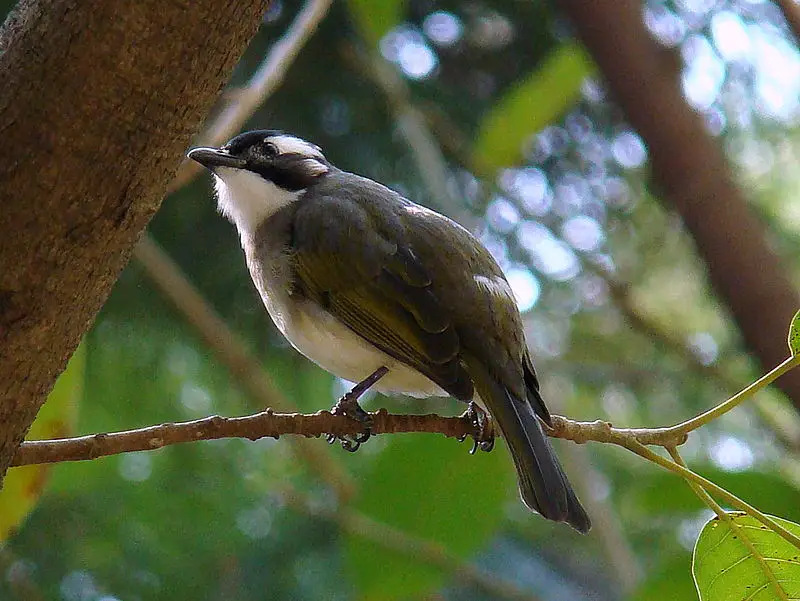
The light-vented bulbul is a species of songbird found in central and southern China, Hong Kong, Macao, northern Vietnam, Japan and Taiwan.
It typically inhabits lightly wooded habitats but can also be seen frequenting towns, suburbs and urban parks.
This bird has olive green upperparts with yellowish underparts; its wings are black tipped with white patches whilst the tail is entirely dark brown.
Its call consists of low whistles that vary from sharp to soft as well as raspy chatters which it uses for communication purposes between members of its flock.
Furthermore this small sized bird feeds on insects such as flies or beetles along with other invertebrates like worms or snails among others making it an important part of many ecosystems across Asia.Scientific classification:
| Kingdom | Animalia |
| Phylum | Chordata |
| Class | Aves |
| Order | Passeriformes |
| Family | Pycnonotidae |
| Genus | Pycnonotus |
| Species | P. sinensis |
Also Featured In: Most Common Birds in China, Most Common Taiwan Birds
2. Asian Emerald Cuckoo
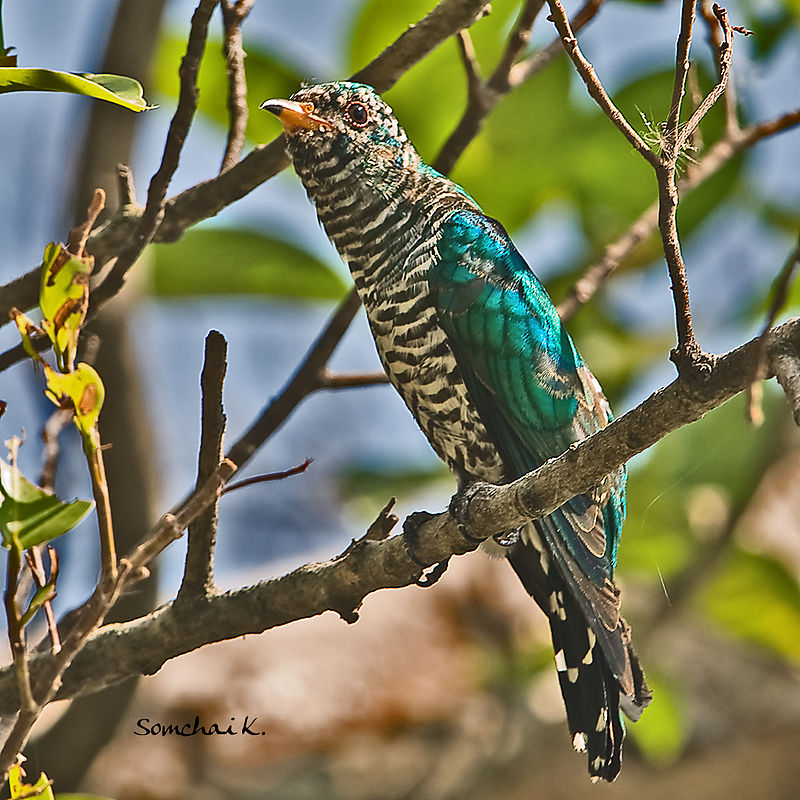
The Asian emerald cuckoo is a species of bird found in South and Southeast Asia. It has iridescent green feathers, with yellow underparts and white speckles along its wings.
Its call is an unmistakable high-pitched whistle that can be heard up to 1 km away. This unique sound serves as both warning signal for other birds, and attracts the attention of potential mates during breeding season.
The diet consists mainly of insects such as butterflies, moths, grasshoppers, flies etc., but they also eat fruits like figs when available.
They prefer lowland or montane forests where there are plenty of trees for them to nest in.
Although their numbers have been declining due to deforestation and hunting pressure from humans; governments across the region are now taking steps to protect this beautiful creature so it may continue thriving in our forests for generations to come.Scientific classification:
| Kingdom | Animalia |
| Phylum | Chordata |
| Class | Aves |
| Order | Cuculiformes |
| Family | Cuculidae |
| Genus | Chrysococcyx |
| Species | C. maculatus |
Also Featured In: Common Birds in India,
3. White-Eared Night Heron
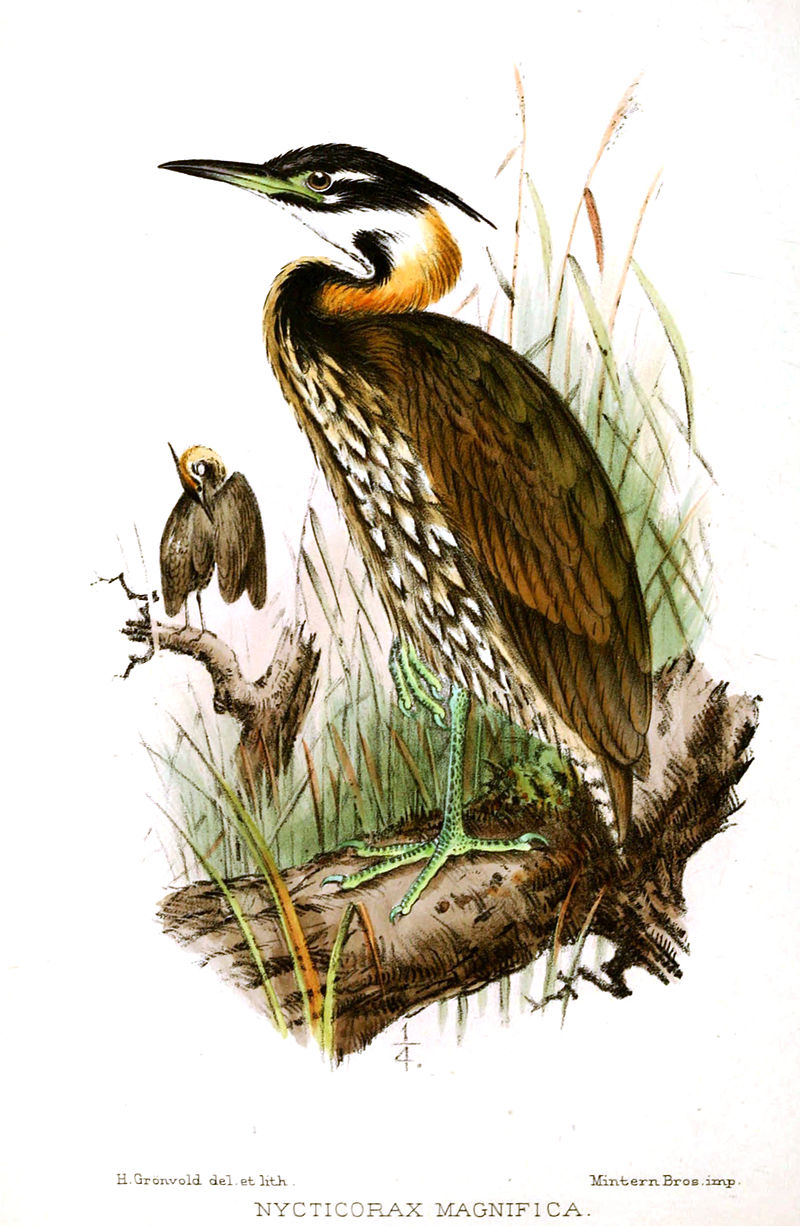
The white-eared night heron is a species of bird in the Ardeidae family native to southern China and northern Vietnam.
It was first collected by John Whitehead on Hainan Island, and described as Nycticorax magnifica b.
Unfortunately, due to habitat loss and fragmentation, this species is currently threatened with extinction.
In 2018 it was also reported from Valmiki National Park in India which offers new potential for conservation efforts.
The white-eared night heron has striking features such as its dark blue bill, bright yellow legs and large distinctive ear tufts that make up most of its face giving them their namesake appearance.
With proper protection measures put into place they have hope of avoiding further decline or even becoming extinct altogether.Scientific classification:
| Kingdom | Animalia |
| Phylum | Chordata |
| Class | Aves |
| Order | Pelecaniformes |
| Family | Ardeidae |
| Genus | Gorsachius |
| Species | G. magnificus |
Also Featured In: Birds of Vietnam,
4. Silver Pheasant
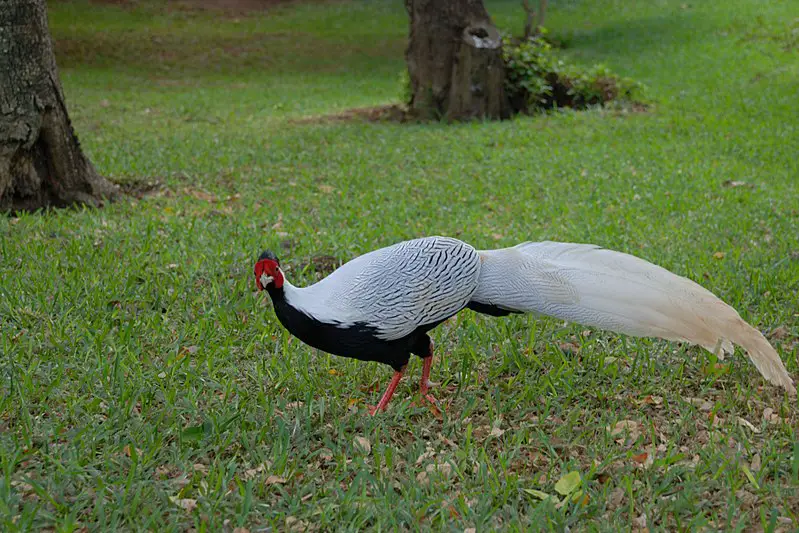
The Silver Pheasant is a stunningly beautiful bird native to parts of Southeast Asia, Eastern and Southern China. This species is known for its distinct black and white feathers in the males, while females are mainly brown.
They both have bare red faces and legs which sets them apart from other birds such as the Golden Pheasant.
The Silver pheasant lives mainly in mountain forests where it feeds on various types of insects, fruits, buds, shoots and seeds.
It has even been introduced to Argentina’s Victoria Island at Nahuel Huapi Lake.
These gorgeous creatures are also popular among aviculture enthusiasts who appreciate their majestic beauty – just be sure to provide plenty of space for these large birds if you hope to keep one as a pet.Scientific classification:
| Kingdom | Animalia |
| Phylum | Chordata |
| Class | Aves |
| Order | Galliformes |
| Family | Phasianidae |
| Genus | Lophura |
| Species | L. nycthemera |
Also Featured In: Silver Birds You Should Know,
5. Puff-Throated Bulbul
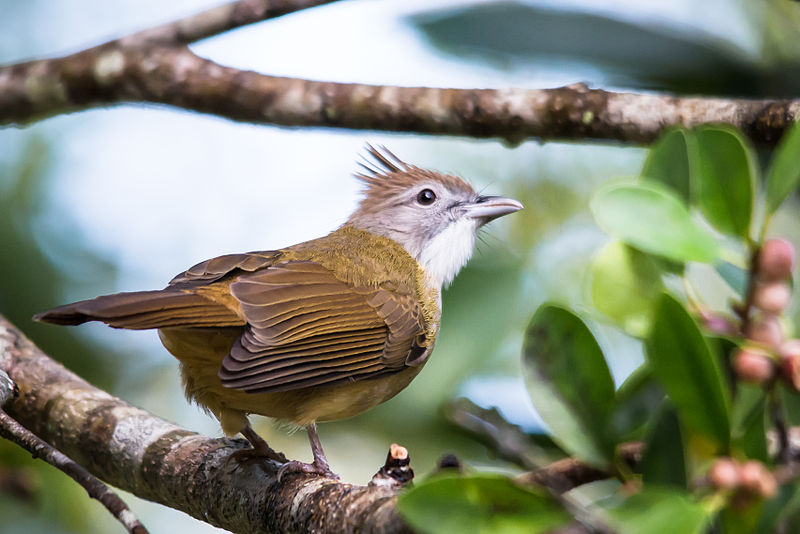
The Puff-throated Bulbul is a songbird belonging to the Pycnonotidae family. It was first discovered by Robert Swinhoe in 1870 and can be found in Southeast Asia, occupying subtropical or tropical moist lowland forests as its natural habitat.
This species of bulbul stands out from others due to its unique features; it has an olive brown upperpart with creamy buff underparts along with a blackish throat patch and crest which gives it its charming name �Puff-throated�.
Its original genus was Criniger until 2009 when researchers moved it into Alophoixus instead.
This bird loves flying around trees looking for fruits, seeds and insects that make up most of their diet.Scientific classification:
| Kingdom | Animalia |
| Phylum | Chordata |
| Class | Aves |
| Order | Passeriformes |
| Family | Pycnonotidae |
| Genus | Alophoixus |
| Species | A. pallidus |
Also Featured In: Birds of Thailand,
6. Orange-Bellied Leafbird
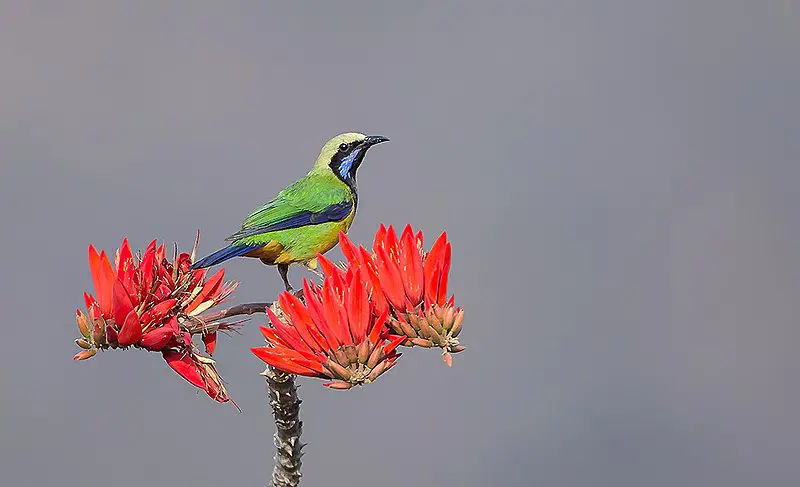
The Orange-bellied Leafbird is a beautiful bird native to central and eastern Himalayas, Yunnan and northern parts of Southeast Asia. It has an orange belly with green back, blue tail and face as well as red wings with black streaks on them.
Its scientific name commemorates the English naturalist Thomas Hardwicke. The Greyish-crowned Leafbird was formerly considered its conspecific but now it’s found in Hainan only.
This species feeds mainly on fruits, nectar from flowers or insects when available like other leafbirds do too.
Its call consists of two notes that are repeated at regular intervals making it easily recognizable amongst birds in this region .
Overall these colourful little birds bring life into their habitats by adding vibrancy to the environment they inhabit.Scientific classification:
| Kingdom | Animalia |
| Phylum | Chordata |
| Class | Aves |
| Order | Passeriformes |
| Family | Chloropseidae |
| Genus | Chloropsis |
| Species | C. hardwickii |
Also Featured In: Birds of Myanmar,
7. Hainan Blue Flycatcher
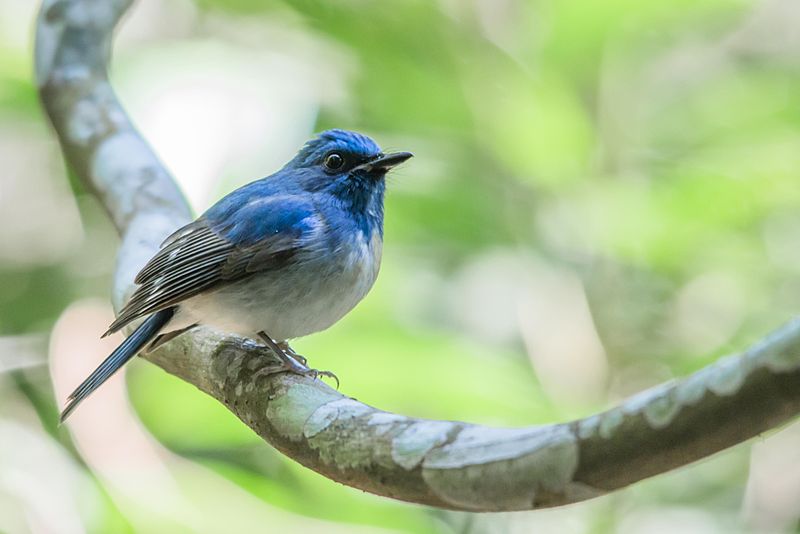
The Hainan blue flycatcher is a species of bird belonging to the family Muscicapidae. It was first described in 1900 by William Robert Ogilvie-Grant and can be found across Southeast Asia, mainly in Cambodia, China, Hong Kong, Laos Myanmar Thailand and Vietnam.
This small passerine prefers subtropical or tropical moist lowland forests as its natural habitat – making them particularly vulnerable if deforestation occurs.
The male has deep blue plumage with black wings while females are duller overall with brownish upperparts and whitish underparts; both sexes have short rounded tails that they often flick rapidly when hunting for insects amongst foliage.Scientific classification:
| Kingdom | Animalia |
| Phylum | Chordata |
| Class | Aves |
| Order | Passeriformes |
| Family | Muscicapidae |
| Genus | Cyornis |
| Species | C. hainanus |
Also Featured In: Birds of Cambodia,
8. Fork-Tailed Sunbird
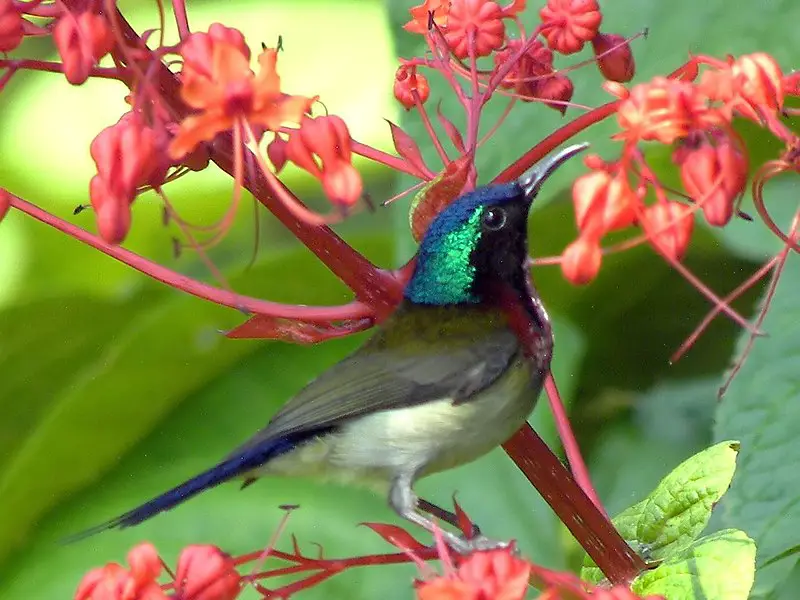
The Fork-tailed sunbird is a small, brightly colored bird found in China, Hong Kong, Laos and Vietnam. It has an unmistakable decurved bill and emits a soft “zwink-zwink” sound as well as a metallic trill.
Its natural habitat is subtropical or tropical moist lowland forests where it can be seen flitting among the trees searching for nectar with its long tongue.
This species was first described by Robert Swinhoe in 1869 and displays striking iridescent blue plumage on its throat while males have scarlet undertail coverts that contrast against their black tail feathers which are split at the end to create ‘forks’.
Females lack this feature but still possess vibrant yellow underparts. The fork-tailed sunbird plays an important role pollinating flowers throughout its range whilst providing us with a beautiful sight of nature’s diversity.Scientific classification:
| Kingdom | Animalia |
| Phylum | Chordata |
| Class | Aves |
| Order | Passeriformes |
| Family | Nectariniidae |
| Genus | Aethopyga |
| Species | A. christinae |
Also Featured In: Birds of Laos,
9. Grey Treepie
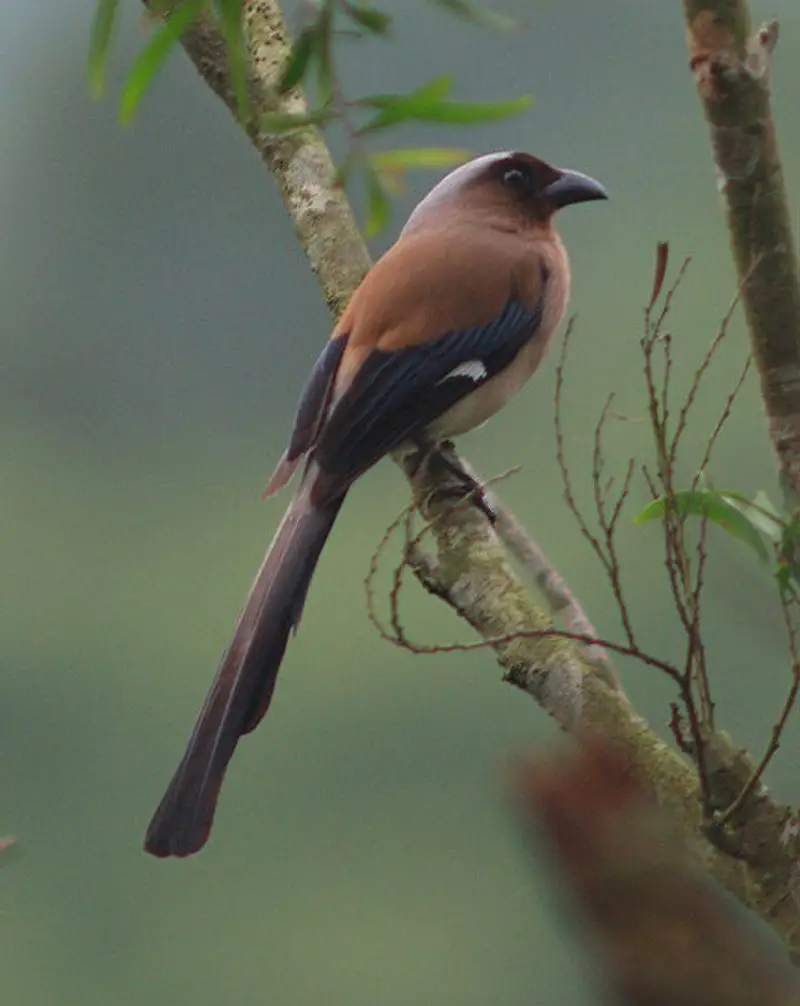
The Grey Treepie is a medium-sized bird belonging to the crow family, originally described by Robert Swinhoe in 1863. It can be found living along the foothills of the Himalayas and extending into parts of India, Indochina, southern mainland China and Taiwan.
Its plumage is mainly grey on its wings and back with white or pale yellow underparts. The tail feathers are usually black tipped with white spots.
They have strong legs adaptable for long hikes over mountainous terrain as they search for food such as insects, fruits, seeds and small reptiles like lizards etc., which make up their diet primarily.
Grey treepies are known for being highly vocal birds who communicate through a range of calls that differ between individuals making them an interesting species to observe.Scientific classification:
| Kingdom | Animalia |
| Phylum | Chordata |
| Class | Aves |
| Order | Passeriformes |
| Family | Corvidae |
| Genus | Dendrocitta |
| Species | D. formosae |
10. Blyth’s Kingfisher
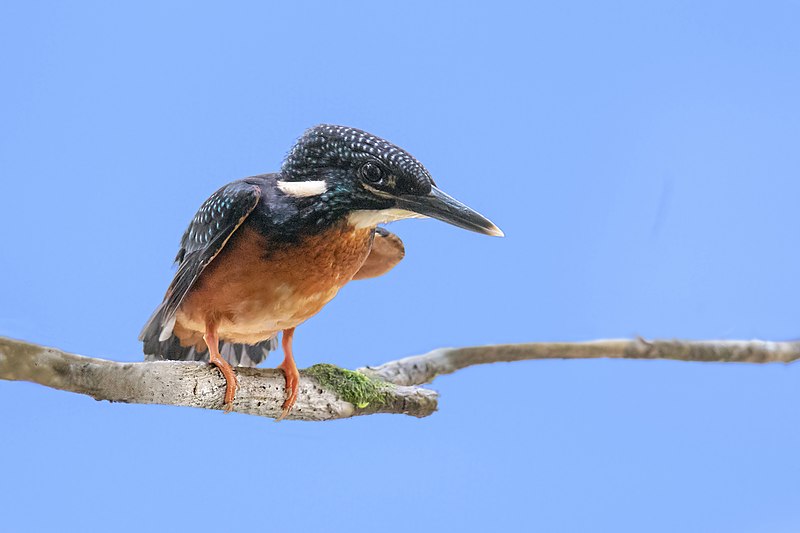
Blyth’s kingfisher, named after Edward Blyth, is the largest kingfisher in its genus Alcedo. It has an impressive size of 22-23 cm (8 5⁄8 and 9 in).
Its distinctive features include deep rufous underparts with a blackish blue breast patch, cobalt blue or azure upperparts tinged with purple and long bluish wings.
This aquatic bird loves to feed on fish which it catches by diving into water from a perch or while hovering over shallow waters.
The male attracts female mates through elaborate courtship rituals where they often fly together in pairs even during nesting season when the female builds their nest usually near water bodies like rivers and ponds.
With its vibrant colors this majestic species easily stands out against any backdrop making it one of nature’s most beautiful creatures.Scientific classification:
| Kingdom | Animalia |
| Phylum | Chordata |
| Class | Aves |
| Order | Coraciiformes |
| Family | Alcedinidae |
| Subfamily | Alcedininae |
| Genus | Alcedo |
| Species | A. hercules |
Also Featured In: Bhutan birds,
11. Greater Racket-Tailed Drongo
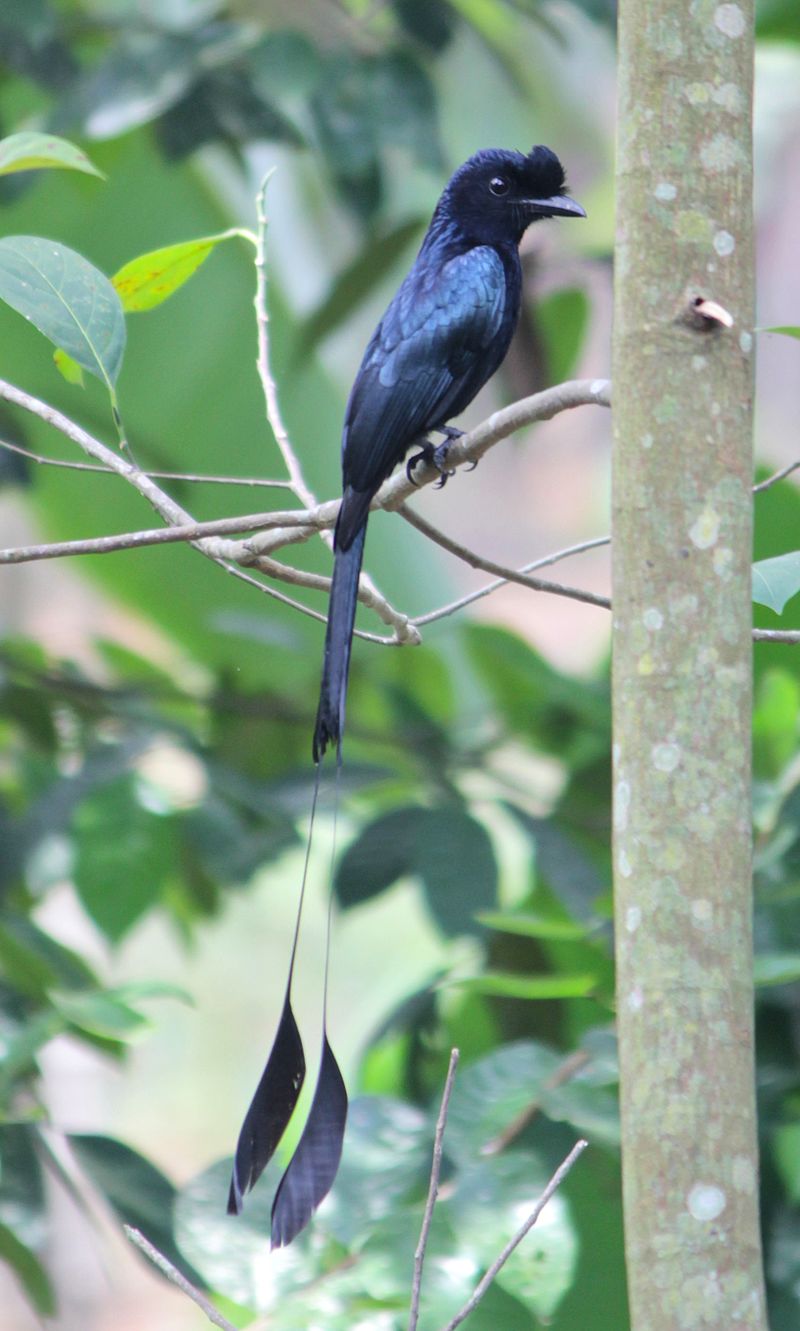
The Greater racket-tailed drongo is a medium-sized bird that inhabits forests in Asia. This bird is easily recognized by its elongated outer tail feathers which have webbing only at the tips.
The Greater racket-tailed drongo is part of the Dicruridae family, which also includes other types of drongos.
They are known for their conspicuous nature, often perching out in the open and using a variety of loud calls that include perfect mimicry of other birds and animals.
They are skilled at attracting attention, and can be seen flashing their long tails to intimidate predators or attract mates.
The Greater racket-tailed drongo is an important member of its ecosystem, helping to control insect populations and acting as a key prey species for predators.
Overall, this bird is a fascinating and important species of the Asian forests it inhabits.Scientific classification:
| Kingdom | Animalia |
| Phylum | Chordata |
| Class | Aves |
| Order | Passeriformes |
| Family | Dicruridae |
| Genus | Dicrurus |
| Species | D. paradiseus |
Also Featured In: Birds of Goa, Endemic Sri Lanka Birds
12. Orange-Headed Thrush
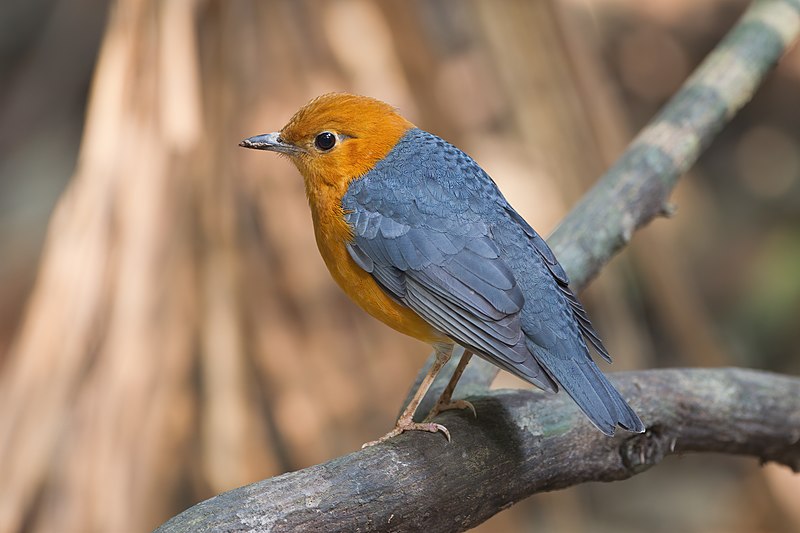
The Orange-headed thrush is a bird belonging to the thrush family. It is frequently found in well-wooded locales of Southeast Asia and the Indian Subcontinent.
This species favors damp, shady areas and tends to be quite secretive, similar to some other birds in the Geokichla and Zoothera thrush families.
The Orange-headed thrush is an omnivore, feeding on a wide range of items, including insects and earthworms.
It is a resident species in most populations.Scientific classification:
| Kingdom | Animalia |
| Phylum | Chordata |
| Class | Aves |
| Order | Passeriformes |
| Family | Turdidae |
| Genus | Geokichla |
| Species | G. citrina |
Also Featured In: Common Birds in Kerala,
13. Red-Headed Trogon
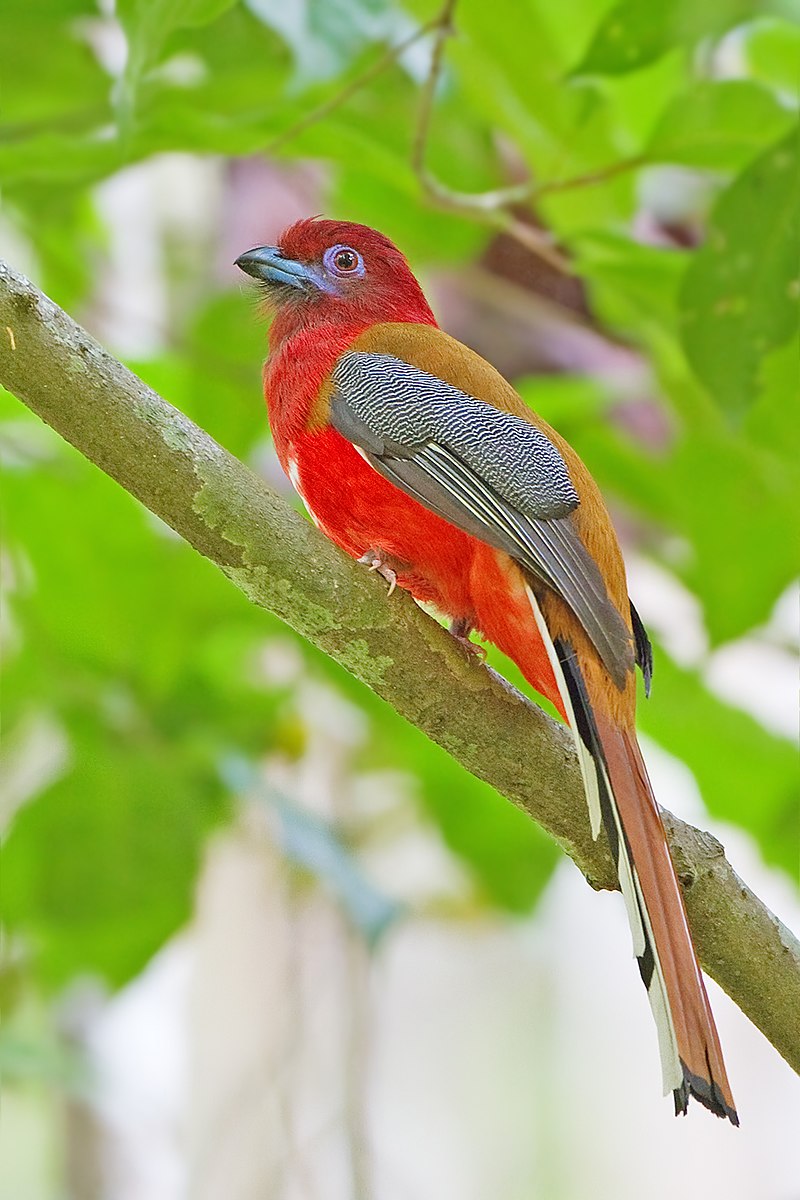
The Red-headed trogon is a bird that belongs to the Trogonidae family. The name of the bird comes from the Greek words ‘eruthros’ meaning red and ‘kephalē’ meaning head.
The male bird has a unique feature with a red head and breast. The Red-headed trogon has an average length of 34 cm. The female of this bird bears a resemblance to Diard’s trogon.Scientific classification:
| Kingdom | Animalia |
| Phylum | Chordata |
| Class | Aves |
| Order | Trogoniformes |
| Family | Trogonidae |
| Genus | Harpactes |
| Species | H. erythrocephalus |
Also Featured In: Birds of Khao Yai National Park, Birds that Commonly Found in Andhra Pradesh
14. Hainan Peacock-Pheasant
The Hainan peacock-pheasant is a rare bird belonging to the Phasianidae family. It can only be found on the island of Hainan in China and is classified as an endangered species.
Initially, it was believed to be a subspecies of the grey peacock-pheasant but was later identified as a distinct species. Unlike its larger counterpart, the Hainan peacock-pheasant is smaller and has a short crest and ruff.
Due to its limited habitat and population, conservation efforts are in place to protect this beautiful bird. Its unique features and status as an endangered species make it a valuable addition to the world’s biodiversity.Scientific classification:
| Kingdom | Animalia |
| Phylum | Chordata |
| Class | Aves |
| Order | Galliformes |
| Family | Phasianidae |
| Genus | Polyplectron |
| Species | P. katsumatae |
15. Hainan Leaf Warbler
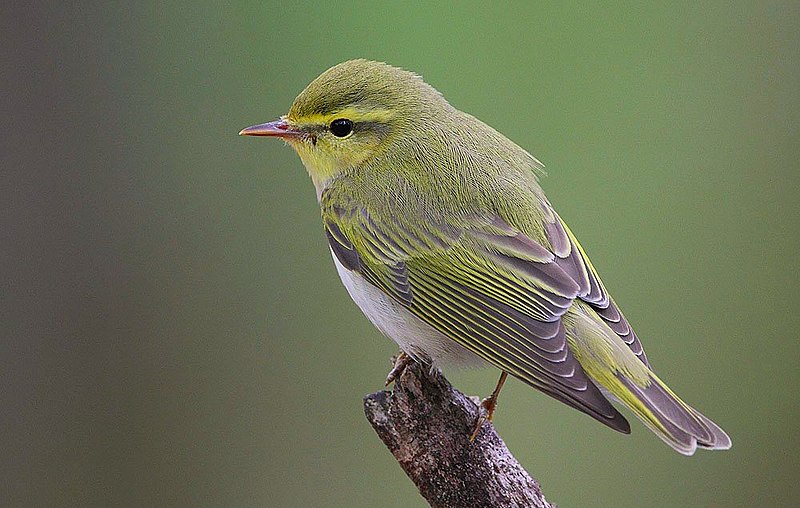
The Hainan leaf warbler is a type of Old World warbler bird that can be found exclusively in China. It is endemic to the southern region of Hainan Island, where it lives in subtropical or tropical moist forests that are lowland or montane.
Sadly, this species is facing the threat of habitat loss and fragmentation, which has put it in danger.
Despite its small size, the Hainan leaf warbler is an important part of its ecosystem, as it helps to control the population of insects and other small creatures.
Its brightly colored feathers and unique songs make it a beautiful and distinct part of the avian world, and scientists are working to protect this threatened species and conserve its natural habitats.Scientific classification:
| Kingdom | Animalia |
| Phylum | Chordata |
| Class | Aves |
| Order | Passeriformes |
| Family | Phylloscopidae |
| Genus | Phylloscopus |
| Species | P. hainanus |
16. Indochinese Green Magpie
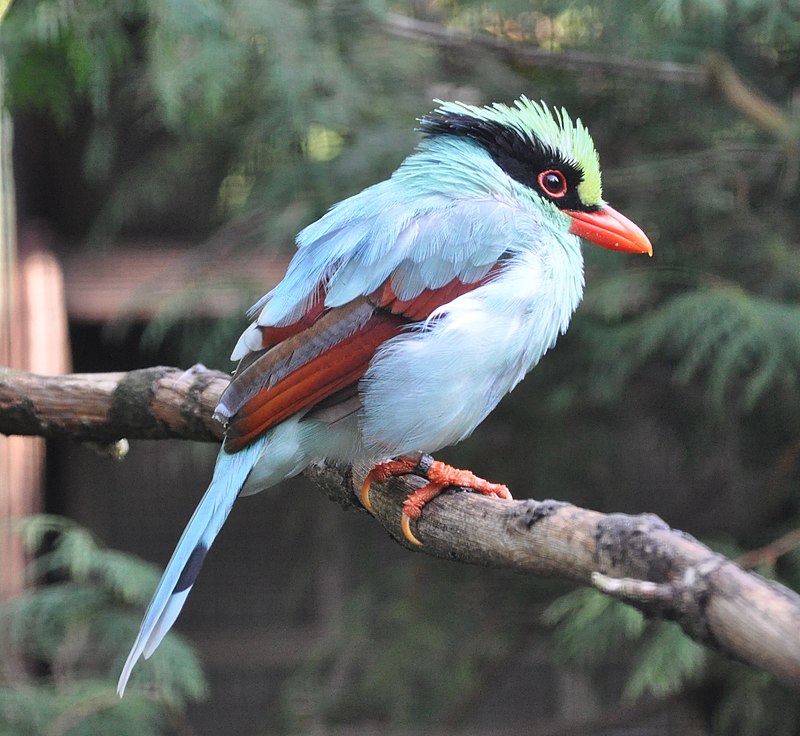
The Indochinese green magpie, also known as the yellow-breasted magpie, is a passerine bird from the crow family, Corvidae. It can be found in mainland southeast Asia and nearby China.
The bird has unique yellow undersides, which distinguish it from other species within the same genus. Apart from that, it has russet coloured wings, green shoulders, head, back, and tail.
Additionally, a thick black band marks the bird on its neck. Despite its distinct features, the Indochinese green magpie prefers to live in dense forests, where it forages on insects, seeds, and fruits.
Although not widely known, this colourful bird is an integral part of the biodiversity and ecological balance of its habitat.Scientific classification:
| Kingdom | Animalia |
| Phylum | Chordata |
| Class | Aves |
| Order | Passeriformes |
| Family | Corvidae |
| Genus | Cissa |
| Species | C. hypoleuca |
17. Dusky Fulvetta
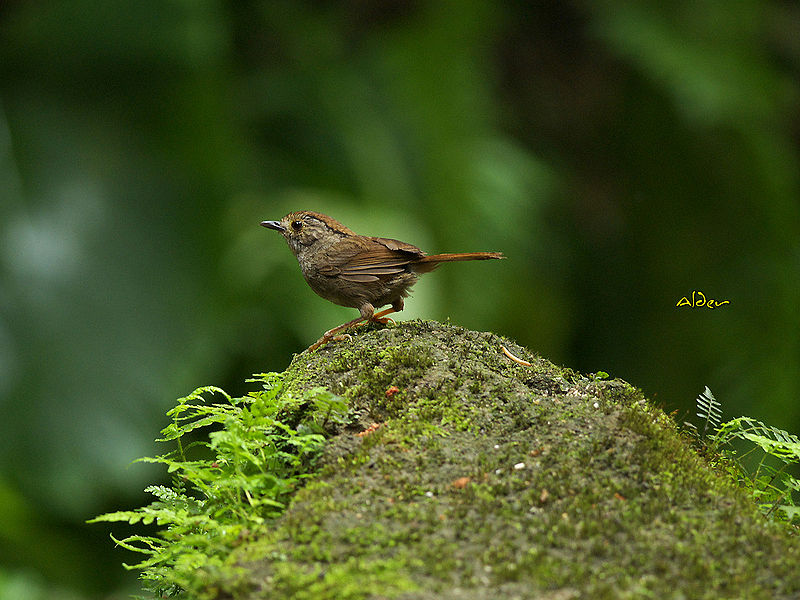
The Dusky Fulvetta is a bird species that belongs to the Pellorneidae family. It is mostly found in the temperate forests and subtropical regions of China and Taiwan.
These birds prefer moist lowland forests to inhabit. They have a unique appearance with a brown-colored body and a short pointed tail.
Dusky Fulvettas are known for their musical calls and display their vocalization skills when they are around their nest.
They also feed on insects found in the forests, and their diet consists of spiders, small bugs, and worms. The bird’s presence adds to the beauty of the forest ecosystem, and the unique features of these birds make them a fascinating study for the ornithologists.
Chirpy and quick on their feet, these birds are a joy to watch in their natural habitat.Scientific classification:
| Kingdom | Animalia |
| Phylum | Chordata |
| Class | Aves |
| Order | Passeriformes |
| Family | Pellorneidae |
| Genus | Schoeniparus |
| Species | S. brunneus |
18. Pale Blue Flycatcher
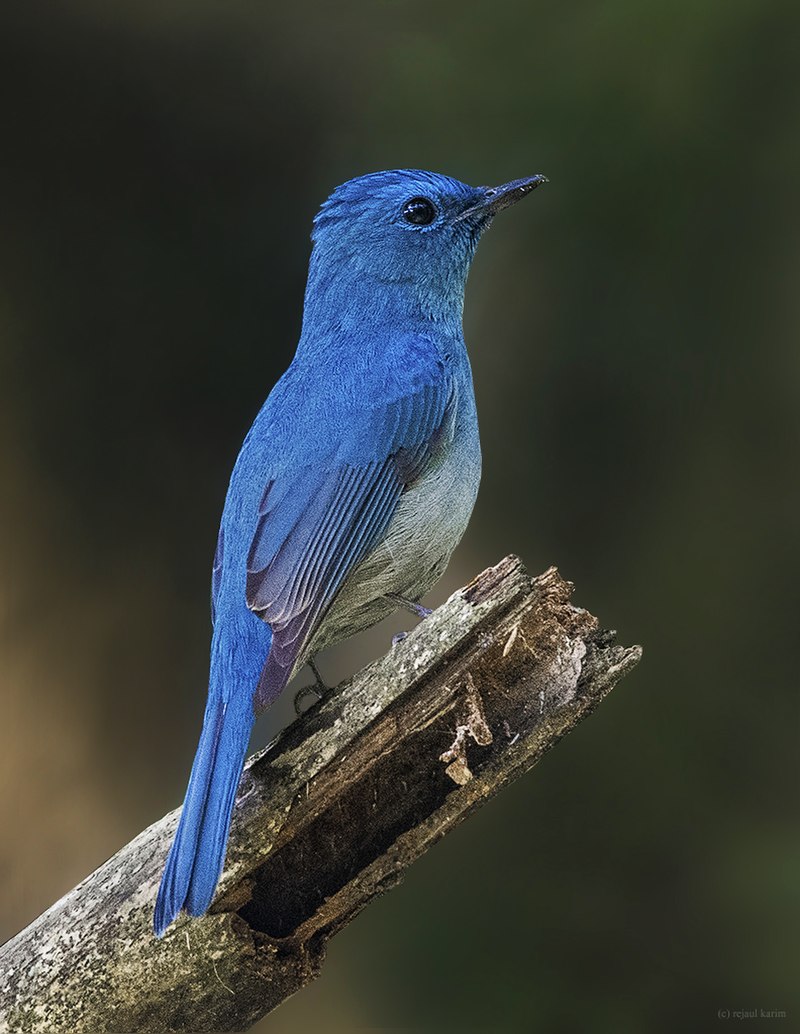
The Pale blue flycatcher is a bird species belonging to the family Muscicapidae. They were initially described by Edward Blyth in the year 1843.
These birds are found in several countries including Bangladesh, Bhutan, China, India, Indonesia, Myanmar, and Vietnam.
They prefer living in subtropical or tropical moist lowland forests and subtropical or tropical moist montane forests. Their body coloration is pale blue, which is where they get their name from.
These birds are known for their ability to catch their prey in mid-air, which is characteristic of most flycatchers.
Although they are not considered endangered, their population may be threatened by habitat loss due to deforestation.
Overall, Pale blue flycatchers are an interesting bird species with unique hunting abilities that we should strive to protect.Scientific classification:
| Kingdom | Animalia |
| Phylum | Chordata |
| Class | Aves |
| Order | Passeriformes |
| Family | Muscicapidae |
| Genus | Cyornis |
| Species | C. unicolor |
19. Spot-Necked Babbler
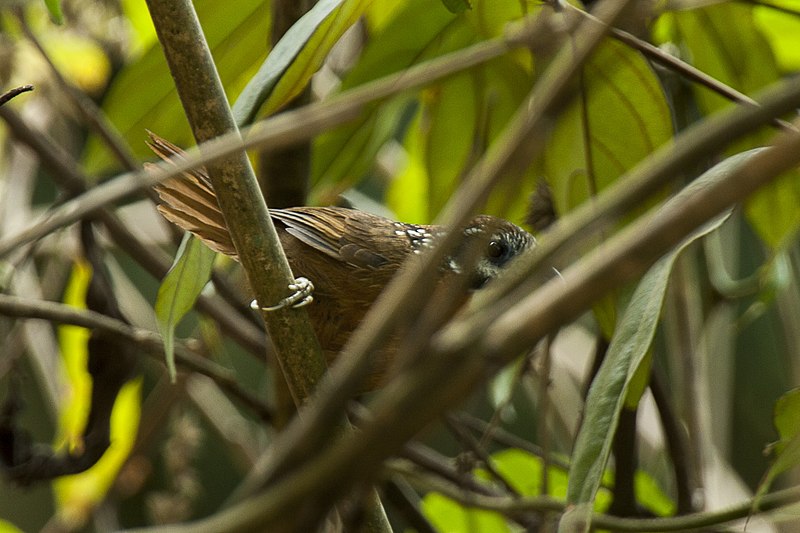
The spot-necked babbler is a type of bird found in several countries including China, Indonesia, Laos, Myanmar, Thailand, and Vietnam. It is part of the Timaliidae family and lives mainly in subtropical or tropical moist montane forest, as well as lowland forest.
This bird has a distinctive spotted neck that distinguishes it from other babbler species. It is of medium size and mostly moves on the ground, searching for its food.
The spot-necked babbler feeds on insects and small invertebrates. This bird’s habitat is under threat from deforestation and habitat loss.
Due to this, the International Union for Conservation of Nature has classified the spot-necked babbler as a species of “Least Concern.”
Although this bird is currently not in danger of extinction, it is still essential to take conservation measures to preserve its habitat and prevent any future decline in population.Scientific classification:
| Kingdom | Animalia |
| Phylum | Chordata |
| Class | Aves |
| Order | Passeriformes |
| Family | Timaliidae |
| Genus | Stachyris |
| Species | S. strialata |
20. Red-Billed Starling
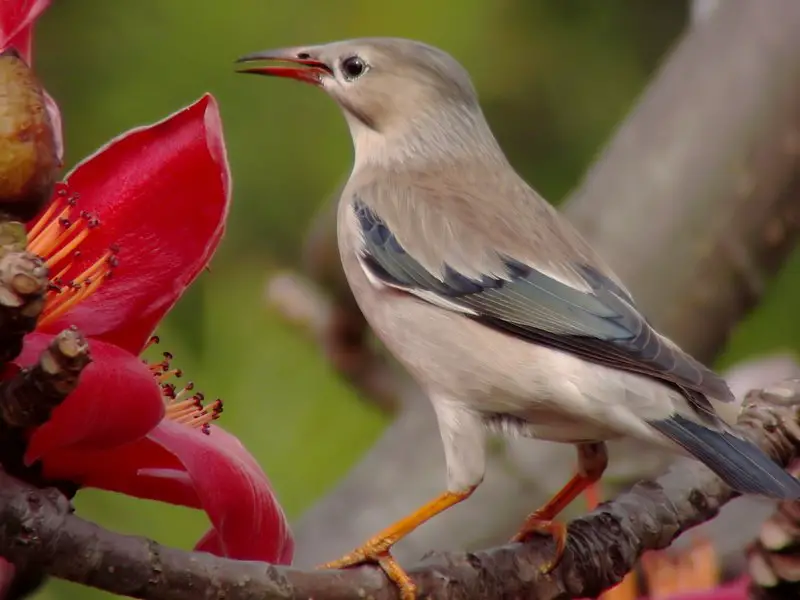
The Red-billed starling is a beautiful bird belonging to the family Sturnidae. It is known for its striking red bill and can be found in the southern and southeastern parts of China.
These birds are characterized by their glossy black feathers and iridescent green and purple sheen. They are social creatures and can often be seen flocking in groups.
The Red-billed starling feeds on insects and fruits, making it an important part of the ecosystem.
Their vocalizations are complex and musical, with an impressive range of pitches and tones.
Despite its stunning appearance and musical abilities, the Red-billed starling faces threats from habitat loss due to urbanization and agriculture. Conservation efforts are needed to ensure the survival of this beautiful species.Scientific classification:
| Kingdom | Animalia |
| Phylum | Chordata |
| Class | Aves |
| Order | Passeriformes |
| Family | Sturnidae |
| Genus | Spodiopsar |
| Species | S. sericeus |
21. Fire-Breasted Flowerpecker
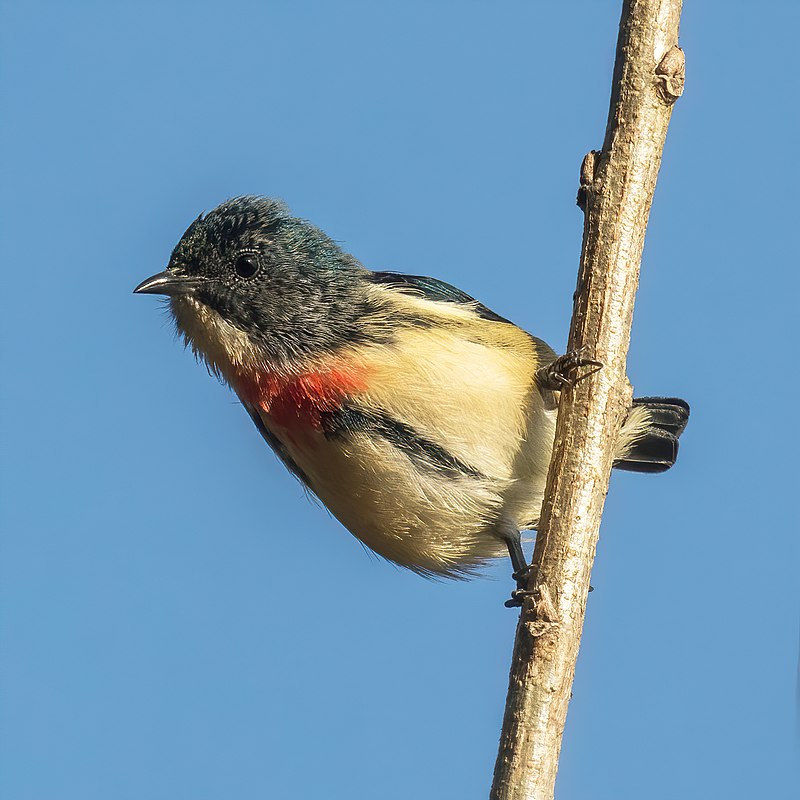
The Fire-breasted flowerpecker is a small bird found in the Indian Subcontinent and Southeast Asia. It is a member of the Dicaeidae family and is known for feeding on fruits and helping to disperse fruiting plants.
Unlike many other flowerpeckers, this species has a striking sexual dimorphism. The male bird has contrasting upper plumage while the female has a more subdued appearance.
Because of its beauty, the Fire-breasted flowerpecker is a popular bird among birdwatchers and nature enthusiasts.
Its crucial role in the ecosystem makes it an important species to protect and conserve. Overall, the Fire-breasted flowerpecker is a fascinating bird that is both aesthetically pleasing and ecologically significant.Scientific classification:
| Kingdom | Animalia |
| Phylum | Chordata |
| Class | Aves |
| Order | Passeriformes |
| Family | Dicaeidae |
| Genus | Dicaeum |
| Species | D. ignipectus |
Also Featured In: Most Common Birds in Negros,
22. White-Winged Magpie
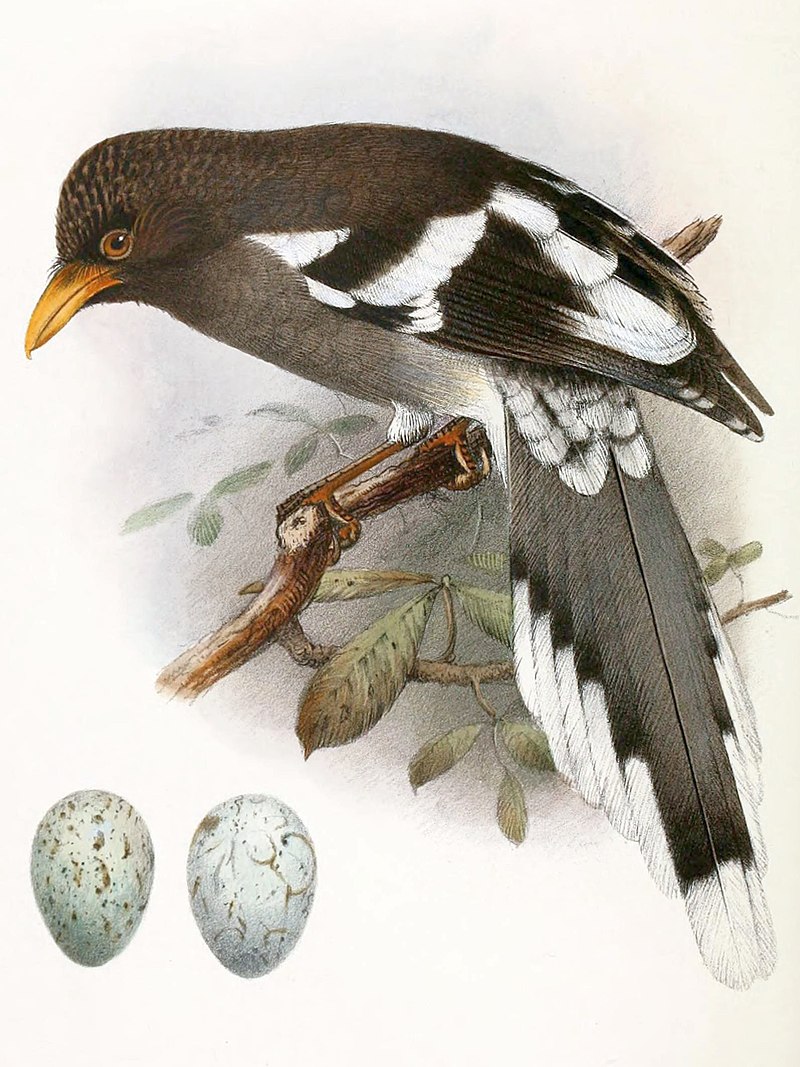
The White-winged magpie, also known as the Hainan magpie, is a passerine bird belonging to the crow family. It is black and white in color and unusual among its genus, lacking the blue plumage other Urocissa magpies have.
Its unique appearance has earned it the potential for its own monotypic genus, but it still shares enough features to remain in the Urocissa genus.
These birds are known for their intelligence and social nature, often traveling and foraging in small groups.
They have a varied diet consisting of insects, fruits, and small vertebrates. The White-winged magpie can be found in southwestern China, specifically on the island of Hainan.
Unfortunately, their habitat is declining due to deforestation and habitat fragmentation, leading to population declines and making them a vulnerable species.Scientific classification:
| Kingdom | Animalia |
| Phylum | Chordata |
| Class | Aves |
| Order | Passeriformes |
| Family | Corvidae |
| Genus | Urocissa |
| Species | U. whiteheadi |